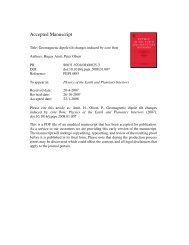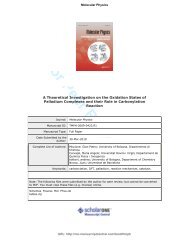parti: objectives and features of the new reporting system 159 - TARA
parti: objectives and features of the new reporting system 159 - TARA
parti: objectives and features of the new reporting system 159 - TARA
Create successful ePaper yourself
Turn your PDF publications into a flip-book with our unique Google optimized e-Paper software.
2 2 Unearned Interest <strong>and</strong> Charges: In <strong>the</strong> case <strong>of</strong> hire-purchase, credit-sale <strong>and</strong><br />
o<strong>the</strong>r instalment-credit agreements, <strong>the</strong> normal practice for financial institutions is<br />
to take future interest into account when <strong>the</strong> loan is issued This means that <strong>the</strong><br />
nominal or face value <strong>of</strong> <strong>the</strong> loans include principal plus all interest pa> able over <strong>the</strong><br />
period <strong>of</strong> <strong>the</strong> loan agreement This practice is at variance with <strong>the</strong> normal accounting<br />
principles used to record o<strong>the</strong>r financial assets m financial institutions' balance<br />
sheets. When <strong>the</strong>se loans are entered at <strong>the</strong>ir face value on <strong>the</strong> asset side <strong>of</strong> <strong>the</strong><br />
balance sheet, <strong>the</strong> interest to be earned over <strong>the</strong> life <strong>of</strong> <strong>the</strong> loan is entered as a<br />
deferred credit on <strong>the</strong> liability side This deferred credit acount is <strong>the</strong>n debited<br />
periodically <strong>and</strong> taken into <strong>the</strong> pr<strong>of</strong>it <strong>and</strong> loss account as <strong>and</strong> when specific<br />
accounting rules recognise a portion <strong>of</strong> <strong>the</strong> deferred credit as income Equivalence,<br />
on an accrual accounting basis, between ordinary loans <strong>and</strong> instalment-credit loans<br />
is obtained by taking <strong>the</strong> face value <strong>of</strong> a normal loan plus accrued interest receivable<br />
<strong>the</strong>reon <strong>and</strong> comparing this with <strong>the</strong> face value <strong>of</strong> <strong>the</strong> instalment-type loan less <strong>the</strong><br />
unearned interest <strong>and</strong> charges applicable to that loan<br />
Because <strong>the</strong> st<strong>and</strong>ard procedures for recording mstalment-type loans tend to<br />
inflate balance sheets by taking into account future income over <strong>the</strong> life <strong>of</strong> <strong>the</strong> loans,<br />
it was decided that instalment loans should be recorded on <strong>the</strong> <strong>new</strong> monthly bank<br />
return net <strong>of</strong> unearned interest <strong>and</strong> charges The exclusion <strong>of</strong> unearned interest <strong>and</strong><br />
charges from <strong>the</strong> private-sector credit series published by <strong>the</strong> Bank means that <strong>the</strong><br />
series is no longer distorted by <strong>the</strong> significant changes in unearned interest <strong>and</strong><br />
charges <strong>the</strong> individual banks' credit figures reflect more accurately <strong>the</strong> 'true'<br />
amount <strong>of</strong> credit extended 10<br />
2 3 Accrued Interest Payable: Interest crediting practices <strong>of</strong> licensed banks, like<br />
<strong>the</strong>ir interest-debiting practices, also have implications for monetary aggregates In<br />
<strong>the</strong> case <strong>of</strong> <strong>the</strong> Associated Banks a very large part <strong>of</strong> <strong>the</strong> interest is credited only<br />
once a year The quarterly or half-yearly interest-crediting practices <strong>of</strong> <strong>the</strong> non-<br />
Associated banks do not have as significant an effect on money supply series<br />
because a large proportion <strong>of</strong> <strong>the</strong> deposits are short term, with <strong>the</strong> result that a<br />
significant amount <strong>of</strong> <strong>the</strong>ir interest crediting takes place at maturity dates <strong>of</strong><br />
deposits ra<strong>the</strong>r than at normal crediting dates<br />
In <strong>the</strong> <strong>new</strong> monthly bank return accrued interest payable in respect <strong>of</strong> deposit<br />
liabilities to both residents <strong>and</strong> non-residents is identified separately <strong>and</strong> broken<br />
down into Irish pounds <strong>and</strong> <strong>the</strong> Irish-pound equivalent <strong>of</strong> foreign currency The case<br />
for including accrued interest-payable in any relevant money supply series is similar<br />
to that presented above for including accrued interest receivable in any credit<br />
series. At any <strong>parti</strong>cular time during <strong>the</strong> year <strong>the</strong> amount <strong>of</strong> funds due to a customer<br />
includes not only <strong>the</strong> amount on his deposit statement but also any amount <strong>of</strong><br />
interest payable to him. When an account is closed at any time during <strong>the</strong> year <strong>and</strong><br />
<strong>the</strong> funds withdrawn, <strong>the</strong> bank repays not only <strong>the</strong> deposit but also any interest due<br />
on <strong>the</strong> account. The inclusion <strong>of</strong> accrued interest payable in money supply series<br />
helps to isolate such series from <strong>the</strong> effect <strong>of</strong> changes in banks' accounting practices<br />
For example, if <strong>the</strong> Associated Banks decided to credit interest to customers'<br />
accounts on a monthly basis, such a decision would have a significant effect on<br />
166
















